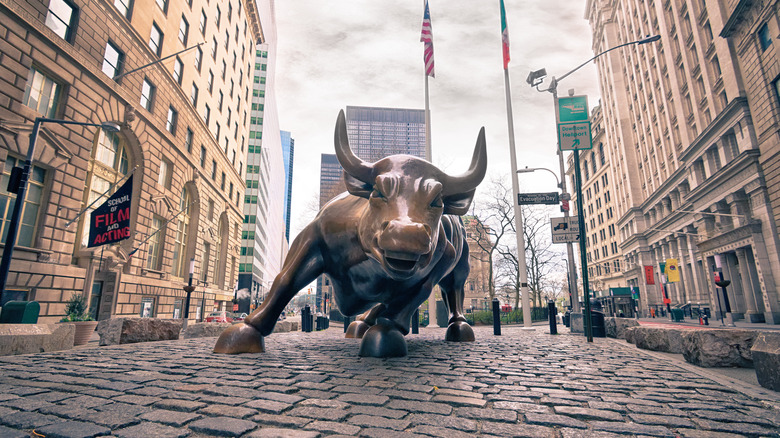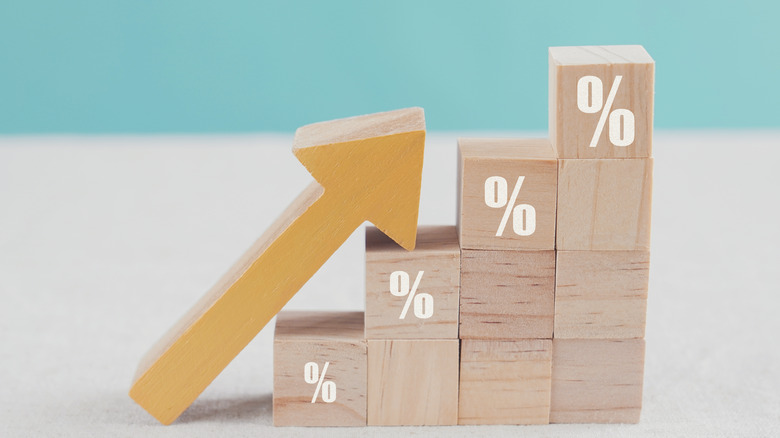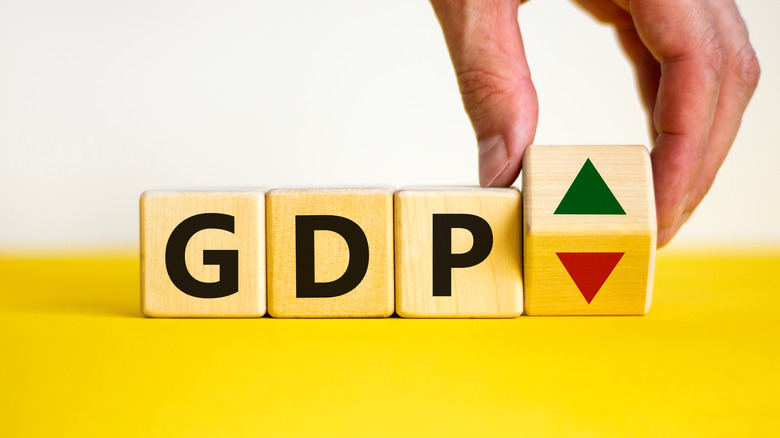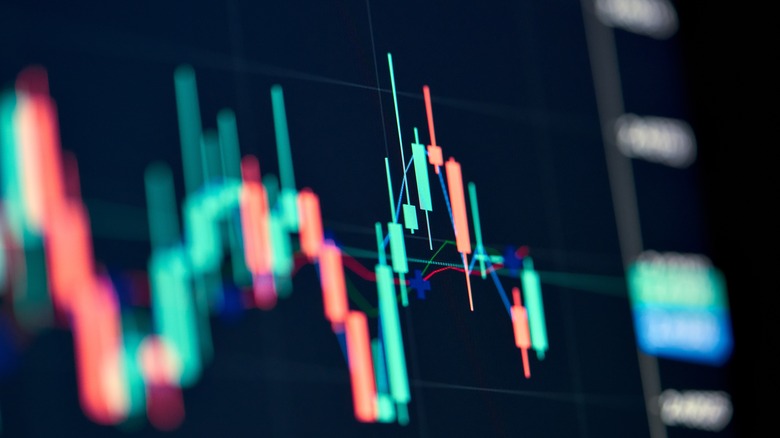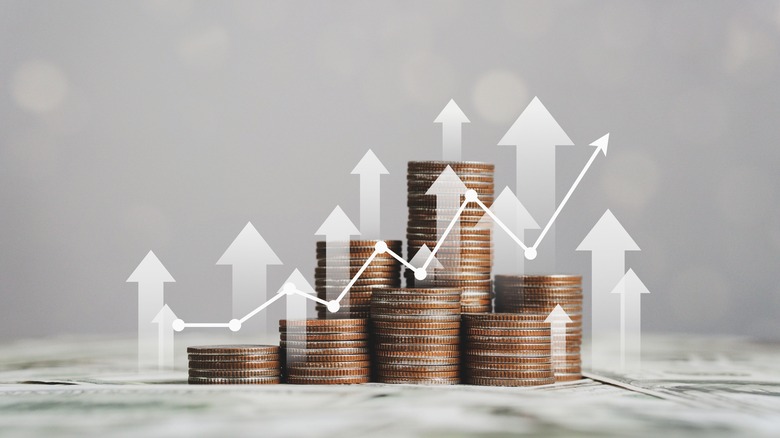What Is A Bull Market? Here's What You Should Know
Investors have invariably heard the terms bull and bear market. These labels are used to denote a period of rising or falling action, respectively, in an asset class. A bull market is one in which assets across the classification are experiencing a generally upward trajectory in price. The U.S. Securities and Exchange Commission reports that this term can be applied to markets when there is a rise of 20% or more across the broader marketplace (i.e., the whole of the national real estate market, gold bullion prices, or the composite stock market index). This must also take place with sustained momentum over a period of at least two months.
Therefore, a bull market is one in which prices are high and confidence in the continuation of trending momentum is also secure.
There's more to know about the bull market phenomenon than just the fact that confidence and prices are rising throughout these periods of trading. Investors looking to make smart decisions about their asset allocation techniques and future planning will want to study past bullish periods and understand what types of marketplace conditions both launch and end periods of bull trading. Put simply, there's a lot to know about these types of marketplaces in order to continue managing a high-performance portfolio of stocks or other commodities.
Continue reading to learn more about the beginnings of bull trading, what an investor might expect during this time, and more.
Prices are on the move in striking fashion
The most pressing feature of a bull market is rising price action that occurs throughout this type of trading period. Bull markets are established when commodity prices rise by 20% or more over a recent level. But a bull market won't form if prices suddenly jump by 20% and then remain static. The classification requires both a large improvement in pricing models and a sustained momentum of upward pricing pressure that can be gradual or electrifying.
Either way, the continued momentum of commodity pricing across the asset class is striking and hard to miss for both investors and non-investors alike. Traders will start flocking to new assets and working to build up increasing levels of market participation in order to take advantage of a prolonged period of price inflation. The more money you have invested in a company that's performing well, the more total dollars you can expect to see as a return on that investment. Rising prices are the most obvious consequence of a turn toward bullish market conditions, but this isn't the only thing that investors can expect to see when fortunes begin to shift and the market produces a bull run.
Consumer and investor confidence is at a high
In coordination with the increasing level of pricing that occurs here, consumers and investors show an increase in confidence in the marketplace and the economy more broadly. As investors begin to consolidate capital and increase their stake in a number of index funds, ETFs, individual stock shares, and more, their actions signal an increasing level of trust in the stock or commodity market and the economic environment that it sits within. Bull markets typically take place when the fortunes of the nation or the world are also moving in an upward direction. This means that, broadly, people are earning good money, consumers are spending, and companies are expanding their reach either within their niche space or beyond it. When consumers are confident in the marketplace and their own financial circumstances, they are more willing to spend money.
In turn, companies experience the same kinds of confidence-building events and pump money into their R&D departments, internal processes, and new and improving product lines, among other things. Recent bull market momentum has coincided with new technological advancements while other bull trading periods have existed during post-war booms and other economic conditions that led to enhanced consumer happiness and confidence. A number of different factors can play a role in creating this uplifting atmosphere, but one thing is certain: A bull market brings about an immense wave of investor and consumer spending that isn't present during times of hardship.
Unemployment is typically low during bullish trading timelines
Another feature that plays a role in this level of economic confidence is the fact that unemployment is typically found to be at some of its lowest rates during these types of market conditions. Unemployment, according to the Economic Policy Institute, is a good indicator of the economic direction that a nation is experiencing at any given point in time. When more people are unemployed than the typical average, government spending must be repurposed to focus on austerity policies and other measures to fight inflation and a sharp uptick in the number of individuals requiring assistance (either for a short or extended period of time).
Similarly, when unemployment rates rise people in local communities stop spending money as freely as they might otherwise. When a person loses their job or leaves it, they tighten their budget in order to make ends meet while they search for a new position. This creates a knock-on effect that will hamper the economic growth of local businesses, especially if many people are facing these tough decisions at the same time.
Conversely, in bull markets, the unemployment rate is typically lower than average or hovers at the low end of a standard range. As such, consumers and investors feel secure in their financial circumstances and freely spend money in their local marketplace and in their investment portfolios alike.
GDP strength combines with savings increases
These features combine to create high-quality GDP numbers. Economic strength is a hallmark of bull market conditions on a broad scale. Not only are consumers spending money in their local economy, but they are also traveling, making splurge purchases, and even moving into new and exciting real estate properties that better suit their needs. Small businesses perform exceedingly well and large enterprises are able to innovate and continue bringing excellent new product lineups and technologies to consumers on a routine basis.
When the economy is booming, says The Federal Reserve Bank of St. Louis, increases in savings typically follow (albeit in a complex relationship). Consumers are able to leverage their capital for both improved buying experiences and savings opportunities in pursuit of both retirement funds and planning for purchases such as a new car, home, or appliance that will improve their overall quality of life. The stock market and other commodity trading spaces are influenced by an impossibly broad variety of factors and circumstances. But one thing that can exert immense pressure on a trading environment is the overall health of the economic space that it exists within. This can be seen today in the fact that the British stock trading space is reeling alongside floundering economic visions for the near future. In contrast, the European and American marketplaces are both seeing challenges but haven't collapsed in nearly as spectacular a fashion.
These features contrast dramatically with the woes of bear trading periods
Bull markets exist in stark contrast to the conditions that persist in a bear marketplace. Bear trading is dominated by investor anxiety, high unemployment, and a vulnerable economic environment. While a bear market signals trouble for a national economy and the people living within that country, bull markets offer a vision of strength for the future and improved fortunes over the foreseeable road ahead.
Bull markets are a great time for investors to expand their position in any variety of assets and to invest in their future more broadly. Where bear trading periods bring about trouble and uncertainty, bull marketplaces are dominated by fast-moving trades and immense confidence in the continued upward price pressure that helps investors everywhere reap fantastic rewards. Of course, as Citizens Bank notes, you can still lose money in a bull marketplace; research and trading fundamentals will carry the day, whether that happens to be in a time of struggle or prosperity. Every investor should do their homework on individual companies that they may be interested in and in strategies for leveraging the marketplace to their needs more generally.
Bull markets are positioned between prolonged downturns
While it can be easy to see bear and bull trade trades as polar opposites, it's important to note that economic circumstances tend to swing in one direction or the other rather than settling into a pattern of static pricing or slow movement. The Journal of Business reports that pricing can often be more or less randomized with simple influence rather than command coming from external sources. This may be due to the fact that publicly traded companies face constant demand from shareholders and company principals to continuously increase profits with each passing quarter. This leads to innovation and competitiveness but can also create an overextension of company assets that leads to dramatic falls in standing or strength.
This same kind of behavior can be seen in a variety of market segments and even in the political realm. Competing visions of economic maintenance and success are often at odds with one another and it's not hard to see why voters might want to elect someone with a different policy vision from time to time.
Indeed, the existence of the bull run almost demands the establishment of its opposite. Because markets can balloon at such explosive rates of growth, they can also shrink with similar gusto. It's important for investors to remember that at the end of every bull run there was likely to be a period of substantial retraction that could potentially last a very long time.
The longest bullish run began in 2009 and only concluded off the back of the pandemic
The longest bull period on record started in 2009. This bull market continued for an incredibly long period of time and many market analysts note that the rise of technology stocks on a broad scale is likely responsible for this elongated trend of upward momentum. However, this bull run is different from others in the stock market specifically. All Star Charts notes that roughly 70% of individual stock assets within the S&P 500 have experienced periods of corrective price action throughout this bull market timeline. The result has been an immensely long period of price gains but not a particularly steady one or a timeline that has produced the highest returns across rising market averages.
Again, this may be due to the fact that technology companies have dominated the modern trading space with FAANG stocks making up a whopping 10% of the S&P 500 index, according to the Corporate Finance Institute. With six companies contributing so much weight to this moving average and their relative strength across the decade of trading, it's clear how such a long trend could be possible. This also showcases the monumental downward pressure that the coronavirus pandemic brought to bear. The disruption of supply chain continuity and the dramatic shift in employment rates and the way that people contributed to their workspace brought this period of bullish ice action to a temporary close.
Two concurrent bull periods opened in 1982 and persisted until 2000
After stagnation in the economy during the 1970s, a bull run began at the tail end of the decade and really took off in 1982 at the end of a period of recession. In the middle of the 1980s, there was a short, three-month corrective period that was then followed up by an elongated bull run throughout the 1990s that only ended with the dot-com bubble burst. During these two decades, the economy was generally performing at a high level and consumer sentiment was through the roof. What's interesting to note about this time in American history is that back-to-back economic strengths could be found under the presidencies of two very different leaders. While politics won't always play a central role in the consumer marketplace and stock market, it's interesting to note that such different visions of governance could each exist in line with an economy that was rewarding investors and consumers.
It's also noteworthy that each of these bull periods saw an explosion in price appreciation of almost double that of the long-running bull market that existed across the 2010s, the First Trust graph makes clear. An investor looking for signs that the market may be turning in a positive direction should take note of the market conditions that played a role in creating each of these three major bull runs that have existed over the last four decades.
Trading in bull markets often involves heavy buy and hold strategies
Most investors engaged in a bull market will look to increase their holdings of certain growth assets that they assess to be of high value and quality. Because prices are generally on the move upward, Admiral Markets reports that one of the best strategies you can employ during a bull market is simply the buy-and-hold approach. This is immensely easy to accomplish and only requires you to understand the kinds of assets that you think will continue to perform well over the long term. Purchasing shares from any company that is continuing to appreciate in value will provide you with consistently mobile returns. Of course, you can only reap these rewards if you choose to sell some or all of your shares. Selling provides you with a payout on your investment but precludes you from continuing to see the benefit of future rising price action leveraged against those shares.
A simple strategy to be sure, but the buy-and-hold approach only requires you to continue investing on a routine basis while leaving the market to create wealth for you naturally. It may also be a good idea to invest in dividend-producing shares of companies that you find valuable. Dividend producers will provide a trickle of excess profits income that's paid out typically on a quarterly basis.
Investing in a bull market means saving for a rainy day
One thing that every investor must understand when approaching a bull market is that this opportunity should not be squandered. The stock market and every other commodity trading space will fluctuate from a position of strength to one of weakness. During down periods, you may not be able to access your invested capital without weathering the effects of serious financial loss. Therefore, you should always operate under the assumption that selling in a bear market can only be done as a last resort.
This also means that other sources of emergency funding will be required to get you through hard times that you and your family might experience during bear market conditions and the economic stress that typically comes along with them. But even as a bear market can produce a number of challenges that must be overcome, careful planning during bull trading opportunities can help alleviate these pressures.
Bull markets are a great opportunity to grow your physical wealth and emergency reserve funding. Investing heavily in the market when prices are on the rise and selling at strategic rebalancing opportunities can help you balloon your available cash and fund emergency resource pools and retirement accounts. Still, it's important to also keep in mind that these added opportunities that come along with bull market conditions should be leveraged as a means of preparation for leaner times that lie somewhere off in the distance.
